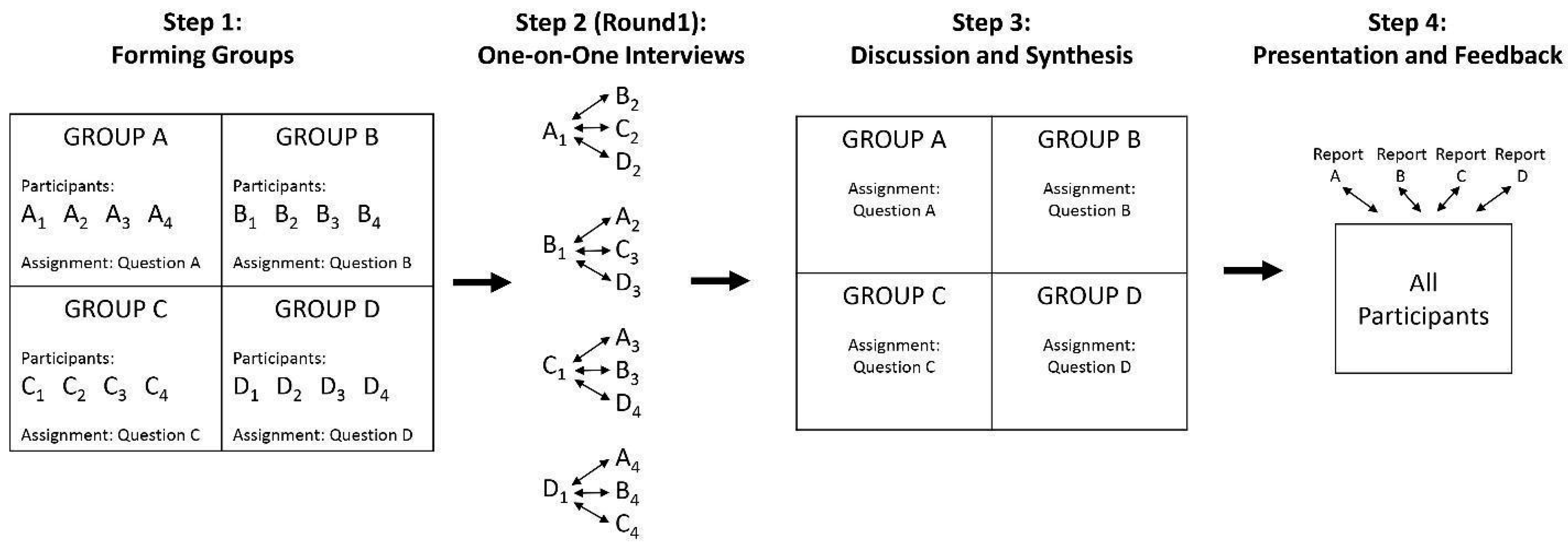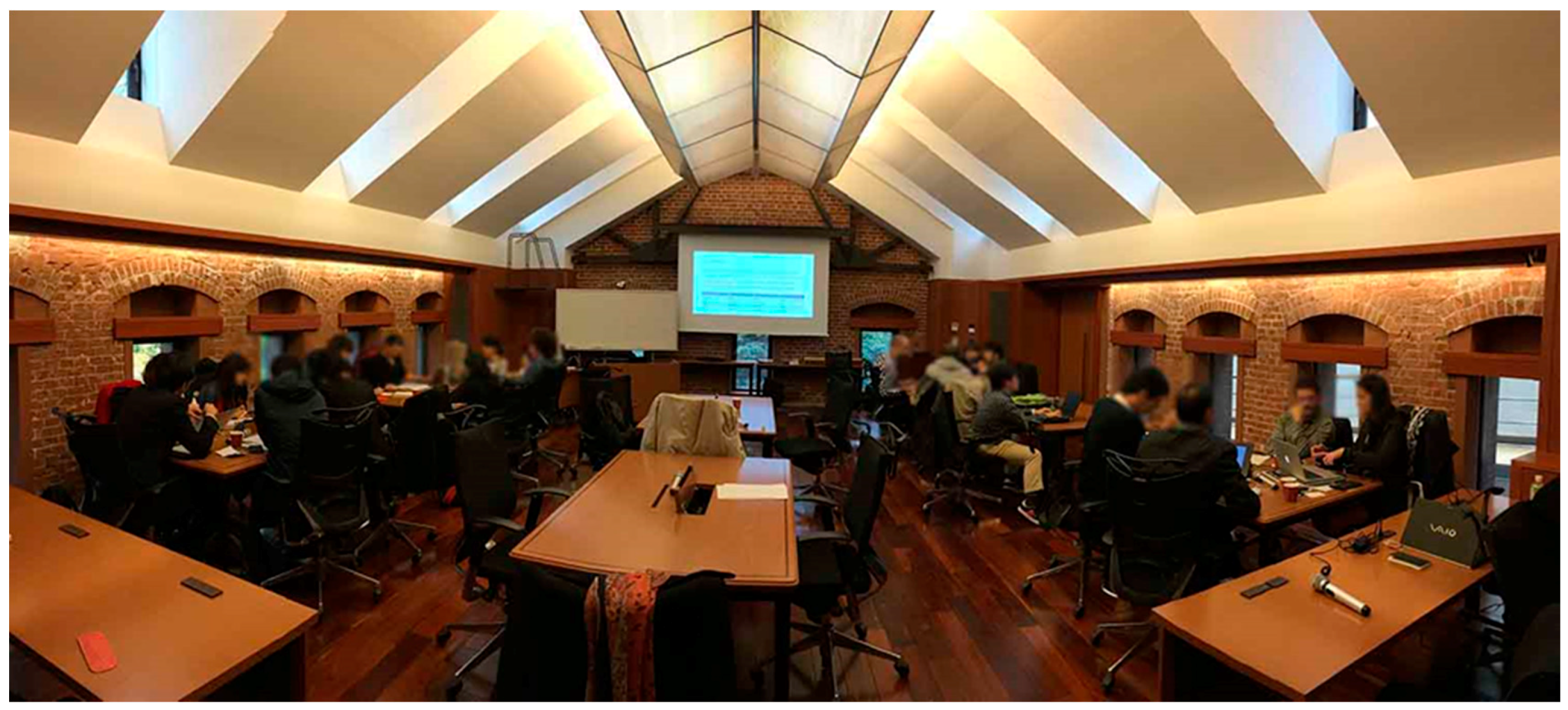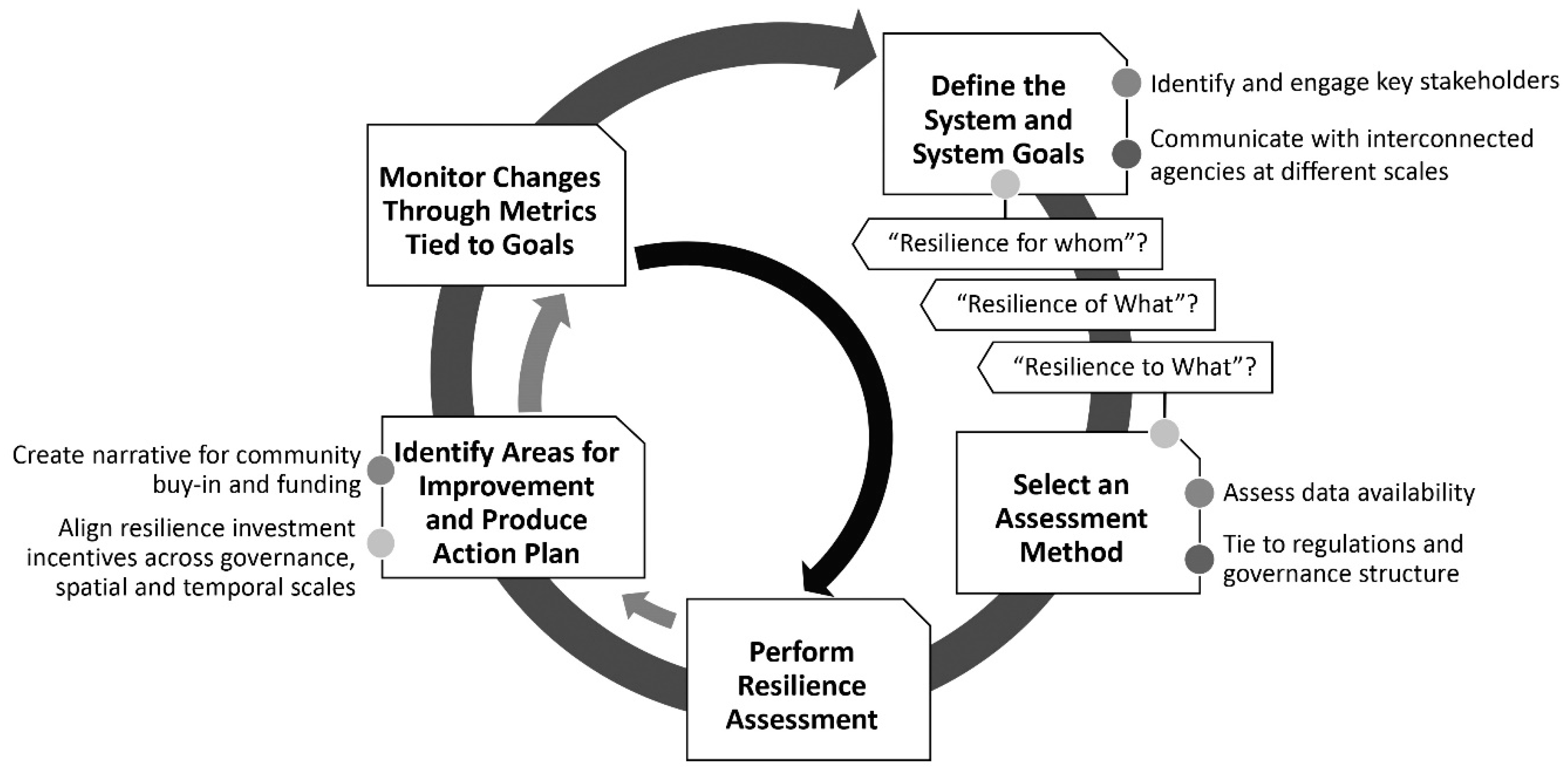Conceptualizing Dimensions and Characteristics of Urban Resilience: Insights from a Co-Design Process
Abstract
:1. Introduction
2. Materials and Methods
- Step 1
- Participants are grouped into small teams, A, B, C, D, each given a different topic (question).
- Step 2
- Members of each group perform one-on-one interviews with a member from each of the other groups to obtain answers to their assigned questions.
- Step 3
- Participants return to their original groups and discuss their originally assigned questions/topics based on the interview results.
- Step 4
- Groups synthesize key ideas and report back to the whole group.
- How does urban resilience relate to adaptation, recovery, and sustainability? What are the synergies/tensions?
- What are the elements of the built environment that influence community resilience?
- What are the elements of the institutional/regulatory context that enable and/or constrain building resilience?
- What are the challenges of conducting resilience assessment and utilizing results to inform decision making?
3. Results
3.1. Relationship between Resilience and Adaptation, Recovery, and Sustainability
3.2. Community Resilience and the Built Environment
3.3. Institutional Elements that Enable and/or Constrain Building Resilience
3.4. Challenges for Resilience Planning and Assessment
4. Discussion and Conclusions
Acknowledgments
Author Contributions
Conflicts of Interest
References
- Coaffee, J.; Lee, P. Urban Resilience: Planning for Risk, Crisis and Uncertainty; Palgrave Macmillan: London, UK, 2016. [Google Scholar]
- Friedmann, J. Toward a non-euclidean mode of planning. J. Am. Plan. Assoc. 1993, 59, 482–485. [Google Scholar] [CrossRef]
- Alexander, E.R. The non-euclidean mode of planning—What is it to be. J. Am. Plan. Assoc. 1994, 60, 372–376. [Google Scholar] [CrossRef]
- Sharifi, A. A critical review of selected tools for assessing community resilience. Ecol. Indic. 2016, 69, 629–647. [Google Scholar] [CrossRef]
- Adger, W.N. Vulnerability. Glob. Environ. Chang. 2006, 16, 268–281. [Google Scholar] [CrossRef]
- Smit, B.; Wandel, J. Adaptation, adaptive capacity and vulnerability. Glob. Environ. Chang. 2006, 16, 282–292. [Google Scholar] [CrossRef]
- Turner, B.L.; Kasperson, R.E.; Matson, P.A.; McCarthy, J.J.; Corell, R.W.; Christensen, L.; Eckley, N.; Kasperson, J.X.; Luers, A.; Martello, M.L.; et al. A framework for vulnerability analysis in sustainability science. Proc. Natl. Acad. Sci. USA 2003, 100, 8074–8079. [Google Scholar] [CrossRef] [PubMed]
- Chelleri, L.; Minucci, G.; Skrimizea, E. Does community resilience decrease social-ecological vulnerability? Adaptation pathways trade-off in the Bolivian Altiplano. Reg. Environ. Chang. 2016, 16, 2229–2241. [Google Scholar] [CrossRef]
- Wilson, G.A. Community resilience: Path dependency, lock-in effects and transitional ruptures. J. Environ. Plan. Manag. 2013, 57, 1–26. [Google Scholar] [CrossRef]
- Christopherson, S.; Michie, J.; Tyler, P. Regional resilience: Theoretical and empirical perspectives. Camb. J. Reg. Econ. Soc. 2010, 3, 3–10. [Google Scholar] [CrossRef]
- Chelleri, L.; Olazabal, M. Multidisciplinary Perspectives on Urban Resilience; A Workshop Report; Basque Centre for Climate Change (BC3): Leioa, Spain, 2012. [Google Scholar]
- Mulligan, M.; Steele, W.; Rickards, L.; Fünfgeld, H. Keywords in planning: What do we mean by ‘community resilience’? Int. Plan. Stud. 2016, 21, 348–361. [Google Scholar] [CrossRef]
- Chelleri, L.; Waters, J.J.; Olazabal, M.; Minucci, G. Resilience trade-offs: Addressing multiple scales and temporal aspects of urban resilience. Environ. Urban. 2015, 27, 181–198. [Google Scholar] [CrossRef]
- Meerow, S.; Newell, J.P.; Stults, M. Defining urban resilience: A review. Landsc. Urban Plan. 2016, 147, 38–49. [Google Scholar] [CrossRef]
- Sharifi, A.; Yamagata, Y. Principles and criteria for assessing urban energy resilience: A literature review. Renew. Sustain. Energy Rev. 2016, 60, 1654–1677. [Google Scholar] [CrossRef]
- Brand, F.; Jax, K. Focusing the meaning(s) of resilience: Resilience as a descriptive concept and a boundary object. Ecol. Soc. 2007, 12. Article 23. [Google Scholar] [CrossRef]
- Leach, M. Re-Framing Resilience: Trans-Disciplinarity, Reflexivity and Progressive Sustainability. A Symposium Report. Available online: https://steps-centre.org/publication/re-framing-resilience-trans-disciplinarity-reflexivity-and-progressive-sustainability-a-symposium-report/ (accessed on 13 June 2017).
- Hassler, U.; Kohler, N. Resilience in the built environment. Build. Res. Inf. 2014, 42, 119–129. [Google Scholar] [CrossRef]
- Lang, D.J.; Wiek, A.; Bergmann, M.; Stauffacher, M.; Martens, P.; Moll, P.; Mark, S.; Christopher, J.T. Transdisciplinary research in sustainability science: Practice, principles, and challenges. Sustain. Sci. 2012, 7, 25–43. [Google Scholar] [CrossRef]
- Huitema, D.; Adger, W.N.; Berkhout, F.; Massey, E.; Mazmanian, D.; Munaretto, S.; Plummer, R.; Termeer, C.C.J.A.M. The governance of adaptation: Choices, reasons, and effects. Introduction to the Special Feature. Ecol. Soc. 2016, 21, 37. [Google Scholar] [CrossRef]
- Karner, S.; Hoekstra, F.; Moschitz, H. Pool of Tools and Method: A Compilation of Tools and Methods for Knowledge Brokerage. Available online: http://www.foodlinkscommunity.net/fileadmin/documents/Common-contents/publications/D23-Pool-of-Tools-and-methods-DRAFT-update-June2013.pdf (accessed on 26 May 2017).
- Participation Compass. Participation Methods 2017. Available online: http://participationcompass.org/article/index/method (accessed on 3 June 2017).
- O’Sullivan, T.L.; Kuziemsky, C.E.; Toal-Sullivan, D.; Corneil, W. Unraveling the complexities of disaster management: A framework for critical social infrastructure to promote population health and resilience. Soc. Sci. Med. 2013, 93, 238–246. [Google Scholar] [CrossRef] [PubMed]
- O’Sullivan, T.L.; Corneil, W.; Kuziemsky, C.E.; Toal-Sullivan, D. Use of the structured interview matrix to enhance community resilience through collaboration and inclusive engagement. Syst. Res. Behav. Sci. 2015, 32, 616–628. [Google Scholar] [CrossRef]
- Vale, L.J.; Campanella, T.J. The Resilient City: How Modern Cities Recover from Disaster; Oxford University Press: New York, NY, USA, 2005. [Google Scholar]
- Newman, P.; Beatley, T.; Boyer, H. Resilient Cities Responding to Peak Oil and Climate Change; Island Press: Washington, DC, USA, 2009. [Google Scholar]
- Matyas, D.; Pelling, M. Positioning resilience for 2015: The role of resistance, incremental adjustment and transformation in disaster risk management policy. Disasters 2015, 39, S1–S18. [Google Scholar] [CrossRef] [PubMed]
- Folke, C.; Carpenter, S.R.; Walker, B.; Scheffer, M.; Chapin, T.; Rockström, J. Resilience thinking: Integrating resilience, adaptability and transformability. Ecol. Soc. 2010, 15, 20. [Google Scholar] [CrossRef]
- Kates, R.W.; Travis, W.R.; Wilbanks, T.J. Transformational adaptation when incremental adaptations to climate change are insufficient. Proc. Natl. Acad. Sci. USA 2012, 109, 7156–7161. [Google Scholar] [CrossRef] [PubMed]
- McPhearson, T.; Haase, D.; Kabisch, N.; Gren, A. Advancing understanding of the complex nature of urban systems. Ecol. Indic. 2016, 70, 566–573. [Google Scholar] [CrossRef]
- McPhearson, T.; Andersson, E.; Elmqvist, T.; Frantzeskaki, N. Resilience of and through urban ecosystem services. Ecosyst. Serv. 2015, 12, 152–156. [Google Scholar] [CrossRef]
- Ahern, J.; Cilliers, S.; Niemela, J. The concept of ecosystem services in adaptive urban planning and design: A framework for supporting innovation. Landsc. Urban Plan. 2014, 125, 254–259. [Google Scholar] [CrossRef]
- Grafakos, S.; Pacteau, C.; Delgado, M.; Landauer, M.; Lucon, O.; Driscoll, P. Integrating Mitigation and Adaptation: Opportunities and Challenges; Cambridge University Press: Cambridge, UK, 2017. [Google Scholar]
- Lu, P.; Stead, D. Understanding the notion of resilience in spatial planning: A case study of Rotterdam, The Netherlands. Cities 2013, 35, 200–212. [Google Scholar] [CrossRef]
- McAllister, T.P. Community Resilience: The Role of the Built Environment. In Multi-hazard Approaches to Civil Infrastructure Engineering; Springer International Publishing: Cham, Switzerland, 2016; pp. 533–548. [Google Scholar]
- Van Nostrand, J.M. Keeping the lights on during superstorm sandy: Climate change and adaptation and the resiliency benefits of distributed generation. NYU Environ. Law J. 2015, 23, 92–154. [Google Scholar]
- Bouffard, F.; Kirschen, D.S. Centralised and distributed electricity systems. Energy Policy 2008, 36, 4504–4508. [Google Scholar] [CrossRef]
- Webb, J. Enabling Urban Energy: Governance of Innovation in Two UK Cities. In Beyond the Networked City: Infrastructure Reconfigurations and Urban Change in the North and South; Coutard, O., Rutherford, J., Eds.; Routledge: New York, NY, USA, 2016; pp. 204–226. [Google Scholar]
- Brody, S.; Kim, H.; Gunn, J. Examining the impacts of development patterns on flooding on the gulf of Mexico coast. Urban Stud. 2013, 50, 789–806. [Google Scholar] [CrossRef]
- Villagra, P.; Rojas, C.; Ohno, R.; Xue, M.; Gomez, K. A GIS-base exploration of the relationships between open space systems and urban form for the adaptive capacity of cities after an earthquake: The cases of two Chilean cities. Appl. Geogr. 2014, 48, 64–78. [Google Scholar] [CrossRef]
- Ioja, C.L.; Gradinaru, S.R.; Onose, D.A.; Vanau, G.O.; Tudor, A.C. The potential of school green areas to improve urban green connectivity and multifunctionality. Urban For. Urban Green. 2014, 13, 704–713. [Google Scholar] [CrossRef]
- Ahern, J. Urban landscape sustainability and resilience: The promise and challenges of integrating ecology with urban planning and design. Landsc. Ecol. 2013, 28, 1203–1212. [Google Scholar] [CrossRef]
- Field, C.; Barros, V.; Dokken, D.; Mach, K.; Mastrandrea, M.; Bilir, T.; Chatterjee, M.; Ebi, KL.; Estrada, YO.; Genova, RC.; et al. Climate Change 2014: Impacts, Adaptation, and Vulnerability, Part A: Global and Sectoral Aspects; Contribution of Working Group II to the Fifth Assessment Report of the Intergovernmental Panel on Climate Change; Cambridge University Press: Cambridge, UK; New York, NY, USA, 2014. [Google Scholar]
- Satterthwaite, D.; Dodman, D. Towards resilience and transformation for cities within a finite planet. Environ. Urban. 2013, 25, 291–298. [Google Scholar] [CrossRef]
- Corfee-Morlot, J.; Cochran, I.; Hallegatte, S.; Teasdale, P.J. Multilevel risk governance and urban adaptation policy. Clim. Chang. 2011, 104, 169–197. [Google Scholar] [CrossRef]
- Bulkeley, H.; Betsill, M.M. Cities and Climate Change: Urban Sustainability and Global Environmental Governance; Routledge: London, UK; New York, NY, USA, 2003. [Google Scholar]
- Beilin, R.; Wilkinson, C. Introduction: Governing for urban resilience. Urban Stud. 2015, 52, 1205–1217. [Google Scholar] [CrossRef]
- Boyd, E.; Juhola, S. Adaptive climate change governance for urban resilience. Urban Stud. 2015, 52, 1234–1264. [Google Scholar] [CrossRef]
- Armitage, D.; Bene, C.; Charles, A.T.; Johnson, D.; Allison, E.H. The interplay of well-being and resilience in applying a social-ecological perspective. Ecol. Soc. 2012, 17, 15. [Google Scholar] [CrossRef]
- Gunderson, L.H.; Holling, C.S. Panarchy: Understanding Transformations in Human and Natural Systems; Island Press: Washington, DC, USA, 2002. [Google Scholar]
- Cutter, S.L. Resilience to what? Resilience for whom? Geogr. J. 2016, 182, 110–113. [Google Scholar] [CrossRef]
- Meerow, S.; Newell, J.P. Urban Resilience for Whom, What, When, Where, and Why? Available online: http://www.tandfonline.com/doi/abs/10.1080/02723638.2016.1206395?journalCode=rurb20 (accessed on 17 January 2017).
- Grafakos, S.; Gianoli, A.; Tsatsou, A. towards the development of an integrated sustainability and resilience benefits assessment framework of urban green growth interventions. Sustainability 2016, 8, 461. [Google Scholar] [CrossRef]
- Redman, C.L. Should sustainability and resilience be combined or remain distinct pursuits? Ecol. Soc. 2014, 19. Article 37. [Google Scholar] [CrossRef]
- Carpenter, S.; Walker, B.; Anderies, J.M.; Abel, N. From Metaphor to Measurement: Resilience of What to What? Ecosystems 2001, 4, 765–781. [Google Scholar] [CrossRef]
- Taleb, N.N. The Black Swan: The Impact of the Highly Improbable Fragility, 2nd ed.; Random House: New York, NY, USA, 2010. [Google Scholar]
- Reed, S.O.; Friend, R.; Toan, V.C.; Thinphanga, P.; Sutarto, R.; Singh, D. “Shared learning” for building urban climate resilience—Experiences from Asian cities. Environ. Urban. 2013, 25, 393–412. [Google Scholar] [CrossRef]
- Sellberg, M.M.; Wilkinson, C.; Peterson, G.D. Resilience assessment: A useful approach to navigate urban sustainability challenges. Ecol. Soc. 2015, 20, 43. [Google Scholar] [CrossRef]
- Sharifi, A.; Yamagata, Y. On the suitability of assessment tools for guiding communities towards disaster resilience. Int. J. Disaster Risk Reduct. 2016, 18, 115–124. [Google Scholar] [CrossRef]
- Ahern, J. From fail-safe to safe-to-fail: Sustainability and resilience in the new urban world. Landsc. Urban Plan. 2011, 100, 341–343. [Google Scholar] [CrossRef]
- Taleb, N.N. Antifragile: Things That Gain from Disorder, 1st ed.; Random House: New York, NY, USA, 2012. [Google Scholar]
- Prior, T.; Eriksen, C. Wildfire preparedness, community cohesion and social-ecological systems. Glob. Environ. Chang. 2013, 23, 1575–1586. [Google Scholar] [CrossRef]



| Method | Objectives | Strengths | Weaknesses |
|---|---|---|---|
| World Café | Participants are divided into small table groups and discuss issues in multiple rounds. Participants (except for the table facilitator) move to a new group at regular intervals and this enables cross-fertilization of ideas. Table hosts summarize and present the main ideas in a plenary session. | Suitable for sharing and generating knowledge Can accommodate a large number of participants Suitable for engaging a wide range of participants Moderate resource requirements (venue, trained facilitators, costs) Short to medium time requirements | Needs clear questions Concrete decisions and action plans cannot necessarily be derived at the end of the process Challenge to facilitators to avoid vocal speakers dominating the conversation. |
| Charrette | This method is applied to create consensus for projects in communities through direct involvement of citizens in the planning process. | Suitable for generating and sharing knowledge Can accommodate a large number of participants Suitable for engaging a wide range of participants | Experts may dominate the process Medium-high resource requirements, depending on the length of the process Consensus building may take time |
| Concept Mapping | Facilitates knowledge gathering and information sharing between a group of people. It can provide useful information on the relationship between key concepts discussed. The technique allows individuals to get involved in effective group discussions without losing detailed individual ideas. | Dominating participants can be avoided Suitable for sharing and generating knowledge Suitable for engaging a wide range of participants | Medium-high resource requirements High time requirements Not suitable for accommodating a large number of participants The process can be complicated for some participants Reaching consensus is not easy |
| Delphi Method | This method is used to extract opinions of a group of experts on a certain topic. Experts take part by answering questionnaires and revising their answers in several rounds. | Dominating participants can be avoided Costs are low | Medium-high time requirements Mainly targeting experts Not suitable for accommodating a large number of participants Lacks dialogue between participants |
| Structured Interview Matrix | This technique is used to facilitate discussions between several groups of participants to elicit knowledge from them. Knowledge is generated and shared through engagement in one-on-one interviews and groups and plenary discussions. Similar to World Cafe but employs interviewing strategies rather than general conversation. | Dominating participants can be avoided Suitable for sharing and generating knowledge Suitable for engaging a wide range of participants Moderate resource requirements (venue, trained facilitators, costs) Short to medium time requirements | Needs clear questions Not suitable for accommodating a large number of participants Relatively new and not frequently used |
| Attribute | Enabling Factors for/Linkages with Resilience | Constraints/Considerations |
|---|---|---|
| Relation to adaptation, recovery, and sustainability | Close linkages with concepts of recovery, disaster risk reduction, and adaptation Achieving resilience (as a high order goal) can be facilitated through continuous and incremental adaptation efforts Synergies of ecosystem preservation with resilience and sustainability Recovery stage can serve as an opportunity to enhance resilience | Tensions in expert communities around the three concepts High emphasis on climate adaptation and resilience may undermine the importance of sustainability How to better articulate conflicts of priorities between different approaches? Adaptation does not necessarily ensure long term sustainability Sustainability measures do not necessarily prepare for future shocks |
| Built Environment | Integrating resilience principles in urban form and building codes Accessibility of urban infrastructures and services (physical and social) Decentralized and distributed infrastructures Street networks that facilitate smooth movement of people and vehicles | Built environment should be viewed in relation to social processes and legislative and institutional frameworks Possible conflicts between economic growth plans and environmental and social resilience of communities |
| Institutional/Regulatory context | Coordination between and within governments; and between government and non-government actors Clear understanding of roles and responsibilities at different levels Transparency, accountability, and participation in public budgets Strong and effective bottom-up institutions, actors, and networks Strong local leadership Risk anticipation and scenario-making capacities | Inherent trade-offs between local and more immediate measures versus long-term measures for resilience building Maintaining continuity of urban resilience policies and implementation on the local policy agenda given the short-term nature of political cycles Weak regulations and enforcement |
| Resilience Assessment | Effective communication strategy to gain buy-in for resilience planning/assessment The form of resilience assessment will inform the options for operationalizing and implementing assessments that can consider and prioritize incremental changes and rehabilitation efforts Proactive resilience activity of one urban community can have important impacts on the population, economy, and demand on services in nearby communities Assessment should include some methodology for prioritizing improvements | Identification and consensus of all relevant stakeholders Framing and communication of the assessment Resilience assessment tools that are both generalized and at the same time adaptable for context-specific applications Defining scales and system boundaries (spatial and temporal) Gaining political buy-in |
© 2017 by the authors. Licensee MDPI, Basel, Switzerland. This article is an open access article distributed under the terms and conditions of the Creative Commons Attribution (CC BY) license (http://creativecommons.org/licenses/by/4.0/).
Share and Cite
Sharifi, A.; Chelleri, L.; Fox-Lent, C.; Grafakos, S.; Pathak, M.; Olazabal, M.; Moloney, S.; Yumagulova, L.; Yamagata, Y. Conceptualizing Dimensions and Characteristics of Urban Resilience: Insights from a Co-Design Process. Sustainability 2017, 9, 1032. https://doi.org/10.3390/su9061032
Sharifi A, Chelleri L, Fox-Lent C, Grafakos S, Pathak M, Olazabal M, Moloney S, Yumagulova L, Yamagata Y. Conceptualizing Dimensions and Characteristics of Urban Resilience: Insights from a Co-Design Process. Sustainability. 2017; 9(6):1032. https://doi.org/10.3390/su9061032
Chicago/Turabian StyleSharifi, Ayyoob, Lorenzo Chelleri, Cate Fox-Lent, Stelios Grafakos, Minal Pathak, Marta Olazabal, Susie Moloney, Lily Yumagulova, and Yoshiki Yamagata. 2017. "Conceptualizing Dimensions and Characteristics of Urban Resilience: Insights from a Co-Design Process" Sustainability 9, no. 6: 1032. https://doi.org/10.3390/su9061032
APA StyleSharifi, A., Chelleri, L., Fox-Lent, C., Grafakos, S., Pathak, M., Olazabal, M., Moloney, S., Yumagulova, L., & Yamagata, Y. (2017). Conceptualizing Dimensions and Characteristics of Urban Resilience: Insights from a Co-Design Process. Sustainability, 9(6), 1032. https://doi.org/10.3390/su9061032





